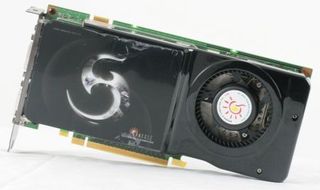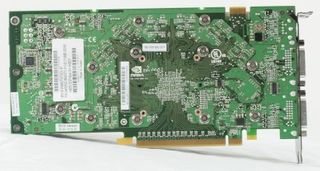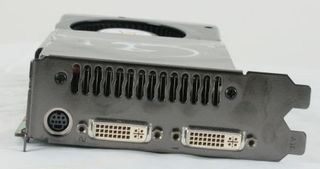Nvidia's GeForce 8800 GTS 512 MB
Sparkle And Gigabyte Cards, The Review
The GeForce 8800 GTS 512 MB strays physically from the smaller 8800 GT first and foremost with regards its dual-slot cooling system. A bigger heatsink/fan duo was indeed necessary to maintain the quiet level of performance found on the GeForce 8800 (even if there are obviously a few variations between models). The heatsink has a copper base on top of which are placed three heat pipes that spread heat over the entire aluminium fins. The first one is cleverly placed as it forces the fans' air flow to pass closer to the base. The latter is still radial and signed by Delta but differs compared to the one found on the previous GeForce 8800 GTS and GTX (which is a good sign). It's slightly smaller (a diameter of 7 cm instead of 7.5 cm), has more blades (which traditionally optimize the air flow in slow regime), is less powerful (4.1 W instead of 5.8 W maximum) and is slightly inclined in order to send the air flow closer to the base. Even though temperatures may exceed 100°C there are no such thing as small improvements.

Sparkle's 8800 GTS 512 MB (front)

and its back... A model similar to that of the reference design
By the way, the PCB used here is the one from the GeForce 7900, which allows savings on production and development costs.
In regards to outputs, as with the 8800 GT, the two DVI-I output must be dual-linked (to manage 30" monitors and their 2560*1600 resolution) and HDCP (cryptographic norm that is becoming more and more inescapable)

DVI dual-link HDCP

PCI Express 6 pins
Stay on the Cutting Edge
Join the experts who read Tom's Hardware for the inside track on enthusiast PC tech news — and have for over 25 years. We'll send breaking news and in-depth reviews of CPUs, GPUs, AI, maker hardware and more straight to your inbox.
The card reviewed was signed by Sparkle. Aside from a sticker on the cooling system and the fan, it's bundled with a DVI-> VGA Adapter, a Molex-> PCI Express 6 pin adapter, a cable for TV and an another one for HDTV. Software wise, only the traditional driver CD is given. It's clear that this bundle is a little poor and Sparkle will have to compete in the price war in order to gain recognition.
Current page: Sparkle And Gigabyte Cards, The Review
Prev Page Specifications Next Page The Review, Continued-
eisley Hi, this is a tricky question, I think. I'm curious. How come a 5 year old video card is only 9 tiers down below the more recent and super powerful 7970 GHz Ed.? (From your most recent Graphics Card Hierarchy Chart) And also it is 8 tiers above the pretty cool Intel HD Graphics 4000?Reply
Does that mean its specs and 512 MB are enough to work with media and play nicely most nowadays games? (at medium-high settings?) I know that does not only depend on the video card, but that chart suggest that.
This can be silly, but I'm looking for a video card like this one. I have a Core 2 Duo E8400 3Ghz/4Gb/IntelQ45 machine that I'd like to improve by adding this video card. Any piece of advice? I'd appreciate it very much. (I know I can try upgrading to some Core 2 Quad, but I'm not to much into games nor editing).
Mostly, what I'd like, besides casual medium-high settings gamming, is what I see in my monitor (videos, images, Windows 7 user interface) is crisp and clear, -much- more than usual. I like high-definition views :)
Please, advice me on that matter. Thank you for your review. That video card looks like it's amazing. And is not that expensive.
- Leo.
(Cheers from Peru!)
Pd: My pc is an original HP Compaq dc7900 Convertible Minitower PC. And my monitor is a Full HD TV (LG LD650) I have another 3D one, and use this one for my comp. And, I'd like the video card to have an HDMI port to conect through it this monitor I use. DVI does the same? Btw.
-
eisley I think I should have said "my monitor will be a Full HD TV (LG LD650)." I couldn't get it to work with my pc cause I need a cable. Which I thought I had. I'll write more details soon. Going to reply the other post. Thanks. ^^Reply
Most Popular


